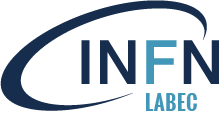The studies on the composition of artworks and on radiocarbon dating represent fundamental ways to enhance our knowledge about cultural heritage to better understand and preserve it for the future.
Artworks are made of materials and elements that can tell us lots of interesting things about the history of such works and about the artists who realized them. For instance, studying the elements a pigment is made of can give us information about the technique used by the painter, or about which materials can be more compatible in case of a restoration as well; the analysis of trace elements can allow us to estimate ancient trade routes and, sometimes, can support an indirect dating.
Dating by measuring the carbon-14 (radiocarbon) residual concentration is one of the most known and widespread methods to absolute date organic samples (in some context, radiocarbon can be exploited to also date inorganic systems as well).
LABEC deals with the study of the composition of artworks by measurements of Ion Beam Analysis (IBA), in particular PIXE (Particle Induced X-ray Emission), and, in a complementary way, XRF (X-ray Fluorescence). Measurements are no invasive and no destructive. IBA measurements are performed exploiting the dedicated beam line at the tandem accelerator where an external beam set-up is installed. XRF measurements are performed using home-developed scanners that are portable for in-situ measurements and allow scanning over large surfaces too.
Radiocarbon measurements are performed through AMS (Accelerator Mass Spectrometry), which allows minimizing the sampled mass from the finding to be dated and get fast measuring times. LABEC is also equipped with a sample preparation lab, where we can treat samples as small as 50 micrograms of carbon.
The activities are carried out with a strong multisciplinary approach collaborating with the most important institutions for the study and the preservation of Cultural Heritage, such as restoration centres, e.g. Opificio delle Pietre Dure, museums and superintendences. LABEC is the leading structure of CHNet, Cultural Heritage Network, the INFN laboratories network working on Heritage science. In the framework of CHNet activities, the laboratory has important international collaborations, such as with the New York University Abu Dhabi and the Universidad Nacional de San Martin, Buenos Aires.
Collaborations are focused both on measurements campaigns on archaeological findings and artworks, and on the development of innovative instruments. Examples of this development activity are MACHINA, the new transportable accelerator, XRF scanners and the combustion-graphitization set-up for small samples to be measured by AMS.

